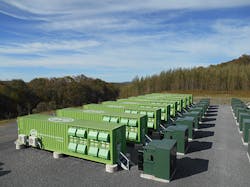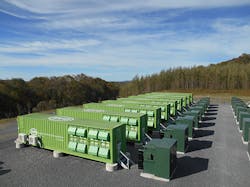Large-Scale Energy Storage Disrupting the Electrical Industry
The latest developments in energy storage promise a greener future for the electrical industry. With more effective and reliable interaction between renewable resources and the grid, greenhouse gas emissions can be reduced. Several studies have been conducted by both the private and public sectors to analyze the impact of such technology on the electrical grid. For example, a study released by Texas utility Oncor Electric Delivery Co. highlighted the many benefits of this technology for the grid:
- Energy storage placement is flexible in that it can be placed in many locations in the grid.
- A storage battery placed on the distribution system (substation or feeder) can be used to prevent distribution outages.
- Distributed deployment of storage can shift power consumption away from costly peak-load periods, reducing peak-load growth on distribution feeders and, therefore, deferring some of the ongoing distribution-system investment needs.
- It can help prevent generation- or demand-side capacity investment.
More research will take place this year following the announcement that Saft (a company involved in the design, development, and manufacture of high-tech batteries used in transport, industry, and defense) has been awarded a megawatt-scale Li-ion (lithium-ion) battery energy-storage contract by Fortum, the Finnish energy company.
A Saft Intensium Max containerized battery system, with a nominal output of 2 MW and 1 MWh, will be installed at Fortum’s Suomenoja power plant (located in Espoo, Finland) as part of the electricity storage pilot project in the Nordic countries (Fig.1). The objective of this pilot project is to research the suitability and optimum usage of batteries used for storing electricity to maintain a power balance in the electricity system.
In addition, the research will explore new opportunities offered by electricity storage and by the flexible intermediate storage of electricity. The capacity of this power plant will be offered to the national grid company Fingrid to maintain a continuous power balance in the electricity system.
“Li-ion batteries provide good cycle life and great energy density. For this project specifically, Saft will use lithium nickel cobalt aluminum Li-ion batteries (commonly named NAC Li-ion),” said Saft’s grid product and marketing manager, Michael Lippert, in a phone interview. Besides highlighting the benefits of Li-ion batteries, he also pointed out the importance of the outcomes of this pilot project because it will help to find out how large-scale energy storage benefits the grid and how Li-ion batteries perform at such high scale.
As the number of energy storage projects increases globally, it is worth mentioning one of the American finalists for the 2015 Project of the Year Awards announced by Renewable Energy World: The Grand Ridge Energy Storage Project at Invenergy’s Beech Ridge Energy Center (Fig. 2). The Grand Ridge Energy Storage Project is a 31.5-MW lithium-ion battery system in operation located in Marseilles, Ill. The project has had great success helping grid operator PJM balance the supply and demand using BYD’s proprietary lithium-ion iron-phosphate battery chemistry.
According to market-research firm IHS, the energy storage market is set to “explode” to an annual installation size of 6 gigawatts (GW) in 2017 and over 40 GW by 2022—from an initial base of only 0.34 GW installed in 2012 and 2013. Energy companies are investing in energy storage because it can help them meet future energy needs and at the same time encourage the use of renewable sources reducing greenhouse gas emissions.
Looking for parts? Go to SourceESB.
About the Author
Maria Guerra Blog
Power/Analog Editor
Maria Guerra is the Power/Analog Editor for Electronic Design. She is an Electrical Engineer with an MSEE from NYU Tandon School of Engineering. She has a very solid engineering background and extensive experience with technical documentation and writing. Before joining Electronic Design, she was an Electrical Engineer for Kellogg, Brown & Root Ltd (London. U.K.). During her years in the Oil and Gas Industry she was involved in a range of projects for both offshore and onshore designs. Her technical and soft skills bring a practical, hands-on approach to the Electronic Design team.


